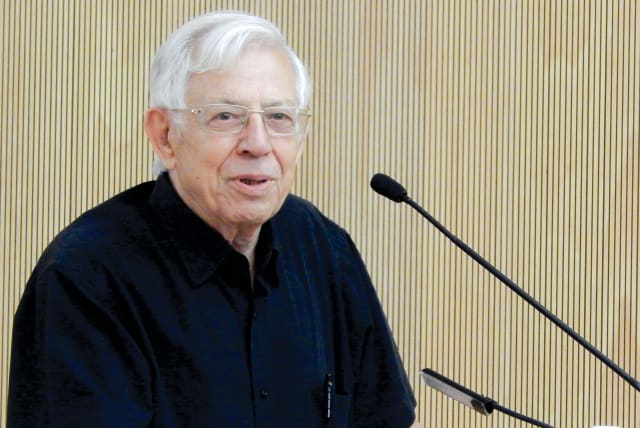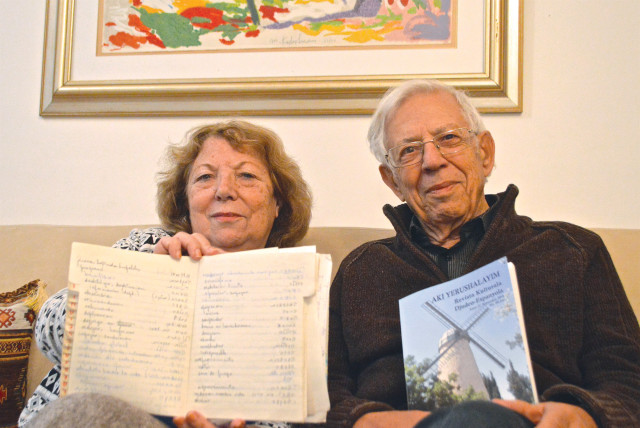Remembering Moshe Shaul: The man who helped revive Ladino

Scholars and Ladino speakers agree that he single-handedly revived the language at a time when it was on the decline and Sephardi culture had lost relevance.
Moshe Shaul, the man who gave Ladino a new lease on life, passed away on April 1 in Jerusalem.
Scholars and Ladino speakers agree that he single-handedly revived the language at a time when it was on the decline and Sephardi culture had lost relevance.
Selim Salti, author and founder of the Naime and Yehoshua Salti Center for Ladino Studies for the Preservation of Ladino and Sephardic Culture at Bar-Ilan University, writing last week in the newsletter of the Association of Turkish Jews in Israel, said that “like a light in the sky, Moshe appeared when our language and its culture was about to disappear and the youngest generations had stopped speaking it.”
He added: “He devoted himself to this endeavor day and night, always thinking that more could be done for Sephardic culture. I was one of those who followed him and for that reason I established the Salti Center in 2003.”
The life of Moshe Shaul, who worked to preserve Ladino and Sephardi culture
Born in 1929 into a Ladino-speaking Zionist family in Izmir, Turkey, Shaul is synonymous with the revival of Ladino, also known as Judeo-Spanish, judezmo, españolit or el espanyol de los djudios (the Spanish of the Jews).
He studied Italian, French and Turkish in Izmir before immigrating to Israel in 1949. In Izmir, he joined the Zionist movement Neeman Zion, where he learned Hebrew, taught Jewish history and prepared young members for aliyah. Upon his arrival in Israel he settled in Kibbutz Tzuba, on the outskirts of Jerusalem, where his older brother, Bohor, was already living. In Israel he studied sociology and political science at Hebrew University.
While I was living in the United States and working as an editor and reporter for Jewish newspapers, I came across Shaul’s name in an article in The Jerusalem Post’s International Edition in 1991, in which he was interviewed about the status of Ladino, but I was unaware of his accomplishments. Later that year, I read an article about Ladino publications, and Shaul’s role as editor of the Jerusalem-based, all-Ladino Aki Yerushalayim was mentioned.
In 1992 I bought all the issues of AY published until that year and paid my annual subscription fees until the magazine’s demise. The entire collection comprises 100 issues, a rare treasure of Sephardi culture like no other.
During a vacation in Israel in 1998, I made time to interview the man whom I considered a linguistic giant, a “Sephardi Ben-Yehuda.”
The interview, which took place in AY’s office on King George Street in Jerusalem, came out in the Forward of New York on April 30, 1999, and introduced AY to American Jews.
After I came on aliyah in 2011, I saw Shaul at several Sephardi events, and he was always warm, cheerful and friendly.
The last time I interviewed him was in December of 2017, a month after it was announced that AY was closing as a print publication after 37 years. With issue 99-100, the magazine came to a sad end. It’s now published online, edited by Aldo Sevi.
Shaul edited AY from the first issue, which came out on April 4, 1979, and had only 18 pages. Several years later, an editorial committee was created, composed of people working in the field of Ladino, among them Istanbul-born Zelda Ovadia, who served as assistant editor. The magazine was published by Sefarad, an association for the conservation and promotion of Ladino culture.
Appalled by the inconsistency in the spelling of the language among Ladino speakers around the world, due to the influence of modern Spanish, French and Turkish, Shaul decided to create a phonetic writing system that “responds to the needs of Judeo-Spanish,” as he explained in an article in the first issue.
His proposed spelling was adopted almost unanimously around the world by scholars, writers and other Ladino publications, such as Shalom and El Amaneser in Turkey, and the now-defunct La Lettre Sepharade in Paris.
AY had several sections: book and CD reviews; philately; food, written by Ovadia; news about upcoming cultural events in different countries; poetry; folktales; biographies; biographical sketches; and a crossword puzzle.
Initially, 1,000 copies of each issue were printed, but the number dwindled to 800, then to 600 and afterwards to 500. Four hundred copies of the last issue were printed, most of which were never paid for by the subscribers, Shaul said during our last interview.
The frequency of AY fluctuated between three annual issues and two. The last issue had the most pages in its history: 118. The only advertiser it had during the 37 years was Ibercaja, a bank from Zaragoza, Spain, which advertised for several years. Shaul said that no other companies were contacted, as they were not interested in an obscure magazine with just a circulation of a few hundred issues.
There were several reasons for the magazine’s decline, according to Shaul. The most frequently cited was financial. For several years, the annual budget of the Autoridad Nasionala de Ladino (Ladino National Authority) for the magazine was NIS 40,000, which over time was cut to NIS 20,000. Despite several donations from individuals and organizations from overseas, the financial crisis in the last years was such that three of the members of the editorial committee – Mordehay Arbell, Ovadia and Shaul – offered to pay for the printing of the last three issues out of their own pocket.
With the closing of AY, Ladino speakers lost the most authoritative voice in Sephardi culture and the leading publication in that language in the world.
It reached several Latin American and European countries, and even Japan, where there was only one subscriber, and was well received by university professors and students, many of whom were not Jewish.
Besides the AY magazine, there were two Ladino newspapers in Israel. Based in Tel Aviv, they were El Tiempo and La Verdad, which changed its name to La Luz de Israel, and existed between 1950 and 1990. There are some 200,000 Ladino speakers in the country and 160,000 around the world, although few under age 55 speak it as a first language. Experts believe that Ladino will disappear as a spoken language in two generations.
Although AY was Shaul’s crowning achievement, his accomplishments in La Bos de Israel (Kol Israel) aren’t as well known. He joined the radio station in 1954, which started broadcasting in Ladino in June 1948, serving under Yitzhak Levi, a composer, author and compiler of Sephardi folklore and liturgy.
He took over the management of the station after the death of Levi in 1977 and created “Proyekto folklor ladino,” recording more than 3,000 romanceros (songs), refrains and stories from Ladino-speaking immigrants who came to Israel from Turkey, Greece, Bulgaria and the former Yugoslavia. It’s the largest collection of Sephardi of Ladino folklore ever assembled.
From 1997 to 2015, Shaul served as vice president of the Ladino National Authority, created by the Knesset in 1996. At an international conference in Jerusalem on the orthography of Ladino organized by that entity in 1999, he suggested creating a virtual community that would enable speakers of the language around the world to talk to each other, or echar lashon. Rachel Amado Bortnick, a retired teacher from Dallas, Texas, took him up on the idea and created Ladinokomunita in 2000, an online forum in which more than 1,600 members from about 42 countries communicate daily.
In 2018, the Madrid-based Royal Spanish Academy announced the establishment of a Ladino academy in Israel, and Shaul was one of eight corresponding academics in the country appointed by the entity. Ladino is taught at Bar-Ilan University, Ben-Gurion University and Hebrew University. ■
Daniel Santacruz is a teacher and journalist living in Ma’ale Adumim. He recently translated 101 Kuentos modernos de Djoha, a book of Sephardi folktales, from Ladino into English and Spanish, written by Selim Salti and published by Bar-Ilan University. He edits kolsefardim.net, a website specializing in Ladino and Sephardi issues.
Jerusalem Post Store
`; document.getElementById("linkPremium").innerHTML = cont; var divWithLink = document.getElementById("premium-link"); if (divWithLink !== null && divWithLink !== 'undefined') { divWithLink.style.border = "solid 1px #cb0f3e"; divWithLink.style.textAlign = "center"; divWithLink.style.marginBottom = "15px"; divWithLink.style.marginTop = "15px"; divWithLink.style.width = "100%"; divWithLink.style.backgroundColor = "#122952"; divWithLink.style.color = "#ffffff"; divWithLink.style.lineHeight = "1.5"; } } (function (v, i) { });

